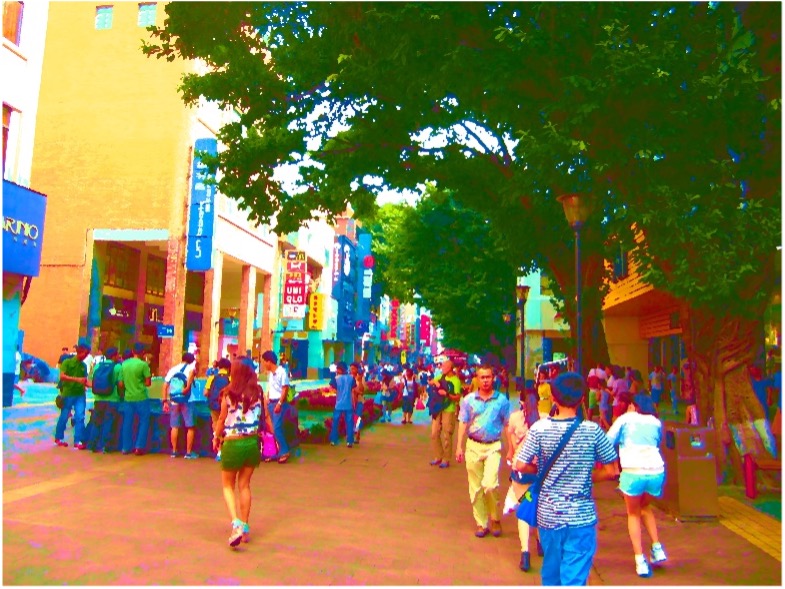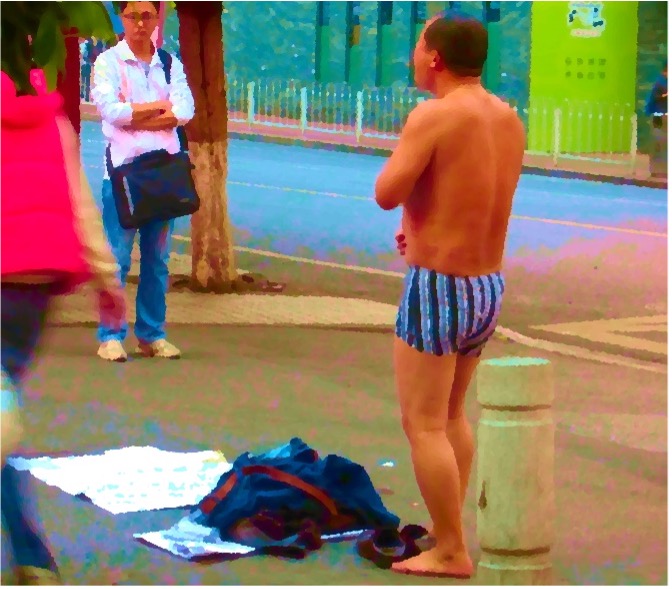Article begins
Performances of panhandling in Guangzhou teach us about public space in modern Chinese cities and elsewhere.
Guangzhou—also known as Canton—is a city of zuo shengyi, of “doing business.” As one of the oldest trade harbors in the south of China, Guangzhou opened up early when the country’s reform program of 1978 reintroduced the importance of money and markets. As a result, its bustling shopping streets are loud and radiant, with music blaring from the stores and clerks or automated megaphones shouting out the latest offers. Uniqlo, KFC, Metersbonwe—well-established national and international brands—speak of comfortable wealth and guangjie (window shopping) as a way to relax and enjoy life (Figure 1).

The greater the contrast, then, when I observed a scraggy woman asking for alms by crawling in the middle of the Beijing Road Pedestrian Area, the city’s retail center. Barefoot and with rolled-up sleeves, she exhibited her body’s disabilities: no fingers, deformed toes. Amid her stuffed and worn bags stood a crying toddler. A crowd gathered around the heartbreaking scene, and a skirted lady jumped forward to help while the urban management personnel became nervous. Usually, these patrols hired under the umbrella of Chengguan—the bureau in charge of an orderly cityscape—expel beggars from the shopping street. But this time, the officials in their dark-blue uniforms did not intervene. I was intrigued by this scene and its broader implications. How do beggars gain access to public space in Guangzhou through such performances, navigating local governance and social norms?
Scholars often define begging or panhandling (I will use these terms interchangeably) as asking for money or goods in public space. However, I found performances in China more intense and elaborate than those described in the academic literature or encountered during my travels in “Western” cities. I observed various ways of asking for alms in different urban locations for four years (2010–2014) in Guangzhou and talked to people panhandling in the present or the past. I approached beggars as a vulnerable social group, aiming to create situations of trust and free of hierarchies. We met in public places where we generally felt safe while also considering the attention of public security personnel. Most beggars I met responded to Chinese regional disparity and migrated from the deprived countryside to wealthy Guangzhou. Moreover, their capacities for physical work were limited due to age, illness, or disability, and they lacked family and state support. The turnover rate among this group was high during my fieldwork, and I cannot say how many are still in Guangzhou. Their agency, however, teaches us about public space in China and in a modern city. In the following, I will show how panhandling adapts to a changing spatial culture and the local state’s attempts to “beautify” the commons.
In Guangzhou, ways of panhandling differed according to space. There was a strong contrast between religious sites versus areas of commerce, entertainment, and transport. Some beggars slept in areas near temples and churches in the evening, stored their belongings in the bushes, and stayed longer during the day, panhandling but also chatting and relaxing with acquaintances. Visitors to these places of worship gave a few Yuan to most of them. Interestingly, at shopping and bar streets, and other commercial spaces of lively foot traffic, the performances were unusually comprehensive and layered, incorporating sight, sound, and story.
Contrasting with the middle-class environment, beggars stood out with their simple and sometimes worn-out clothes, sad demeanor, and stooped postures. Many exhibited injuries, mutilations, and burned and diseased skin. One day, I saw a healthy-looking man in his mid-30s stripping down to his underpants (Figure 2). He stood silently, his head bowed, his clothes at his feet. The skin expressed his neediness and desperation by renouncing his social “face” (mianzi). Additionally, he laid out a big poster in front of him to tell his story. Later, I realized that many beggars explained their reasons for poverty and panhandling in writing. I saw smaller notes and big declarations arranged with photos, hospital reports, and other official documents. “I suffer from rheumatism, the many years of treatment have not been effective, and I became disabled, for a long time I could not get out of bed, and [the challenges] of daily life are [still] difficult for me to handle.” The author of this piece specified his home village via province and city; others presented their ID or added phone numbers. In most of these scenes, passers-by stopped to read and some put a few Yuan in the beggar’s cup. Andrew Travers argues that begging is a staged “self-destruction” to create a hierarchy which argues: You are better off; you are in the position to help me.

When I met 70-year-old Mr. Song, he too was lying on his stomach, moving on a rolling board. However, he was busy writing calligraphy with a moist brush on the pavement, completing an ever-growing artwork by outlining the characters with colorful chalk. Three years ago, he told me, he was panhandling by waiting for alms with a bowl in his hand. But people insulted him because they could not see his leg disease, and he feared their contempt. Thus, he started street calligraphy, feeling that he would give something back, nurturing his self-esteem. Other panhandlers combined performances of misery with music, singing, or playing an instrument. Referring to Mr. Song’s explanation, we can understand this not only as a strategy to gain more attention and alms but also to deal with the stigma of begging and handling the hierarchy toward the audience. However, his answer also made me think of the “deserving poor”—a ubiquitous discourse in Chinese society—and the words of panhandling Mr. Mo: Only when you see someone’s disability can you be sure a beggar is “real” (and therefore deserving). Could emphasizing physical challenges as part of panhandling performances be a form of empowerment to have a claim on help and even access to public space?
Today’s Chengguan Bureau was established in the late 1990s to create an orderly and “civilized” city inspired by the clean streets of other world metropolises. At the same time, however, the social issues caused by the market transition intensified and urged more “humanist” governance, according to the official jargon. Thus, on the national level, the State Council emphasized that panhandling is not forbidden; instead, those in need should be offered assistance and not be harassed in any way. Yet, on the local level, Guangzhou and other cities issued regulations defining panhandling as an aesthetic disturbance which should be punished and removed from public space. The policy contradictions leave patrols in a legally grey area when approaching beggars.
Chengguan tolerated asking for alms at religious settings. Once in a while, I saw them drive by Guangzhou’s famous Guangxiao Temple, but their patrols were nowhere to be seen most of the time. Instead, they concentrated on areas of commerce, entertainment, and transport. Mostly in groups, by foot or electrical cart, Chengguan personnel moved back and forth within the radius of their responsibility. They expelled beggars from these popular and prestigious areas, sometimes with a frown or harsh words, while most beggars avoided the confrontation. Mr. Song wrote his calligraphy near Beijing Street—not under Chengguan’s immediate gaze, but within a regularly controlled radius. He would panhandle until a patrol shooed him away, he explained to me. Watching the comprehensive performances, I realized that most beggars seemed to make the most of the time given, trying to convey the message of misery and deservingness as fast and efficiently as possible.
Moreover, variations in governance and performance relate to the specific spatial culture grown through a place’s history and social functions, connected to social norms and accepted behavior. If we think of religiosity as a market of transcendent ideas whose members gain self-affirmation through charity, then beggars belong to churches, temples, and mosques. Observing how visitors gave alms almost automatically, I understood that those asking for alms were integral to the ritual of piety and did not need to perform elaborately. However, shopping streets, tourist spots, and metro stations are different: for the Guangzhou city government, they display ideals of modernity and the city’s political and economic success. As this success is contradicted by visible poverty, the number of Chengguan personnel concentrates on those bustling areas. One could argue that panhandling performances adapted to this spatial culture of an entertainment-hungry society as they became themselves a spectacle of sight, sound, and story.
When we encounter ideas of public space—in politics, academia, or the media—the concept is often idealized and defined as open and accessible to all members of society. In our everyday lives, however, we recognize that space is structured; it enables, guides, and limits the agency of individuals and groups. Chengguan’s management is one example of how the state can influence the spatial order and access strategies of marginalized groups. Beggars in China develop various performance skills to fit in, be seen, be heard, and convince and deal with differentiated governance. Thus, access to public space is more than being present; the hierarchy of public space raises questions about social status and performance expectations to benefit from the commons and participate in urban society. Public space is a medium of ordering urban society—a characteristic we must acknowledge if we want to understand its future. For whom and how to lower access barriers and hierarchies, then, is another story.
This piece is part of the SEAA series “The Future of the ‘Public’ in East Asia.” Aaron Su and Jieun Cho are the section contributing editors for the Society for East Asian Anthropology. Contact them at [email protected] and [email protected].

